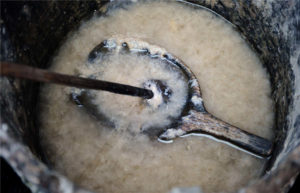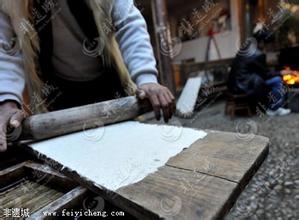Dongba paper is made from the Canescent wikstroemia using a traditional low energy process. Properties of this material include being strong, mothproof and resistant to decay.
Dongba paper is the name given to a paper upon which Dongba religious scriptures were inscribed by the Naxi ethnic group based in Northeast Yunnan, China.
Uses
The only known use is for paper. Nowadays the paper is predominantly sold as tourist memorabilia.
Potential Uses
We wonder what other applications this material could have given its durability and other properties. For instance, could it be used in bulk, not just as single flat sheets? perhaps moulded?
Processes
The Dongba paper is made from the Canescent wikstroemia (latin name Wikstroemia Sikokiana), locally known as asbestos bark or Yan leather. Canescent wikstroemia is a rare shrub (it is suspected that over-harvesting in the past made it rare) which normally grows on mountains with an altitude over 3,000 meters. It has resistant properties that make Dongba paper insect-proof and able to be preserved for a long time. The overall process for converting the raw material into a usable paper is lengthy and relatively complex, with a few additional ingredients required including hemp, shellac and shanhuo grass.
The bark of the tree is used, with the outer blackened skin removed. The bark is sun dried for at least half a day and then soaked in water for a few days (5 days suggested). As the bark becomes softer it is stirred into water which will turn black and smell. Care should be taken as the bark has toxic properties which can cause eyes and hands to itch and sting.
The bark mulch is then combined with a mixture of stove ash, hemp and shanhuo grass. For every 1kg of wikstroemia, 5 kg of stove ash, 50 g of hemp and 25 g of shanhuo grass are added. The additives are mixed in gradually. The mixture is then boiled in a large pot (7 to 8 kg per pot) for 24 hours, stirring occasionally. The boiled mixture will then turn yellowish.

The balls are placed on large stakes and beaten using a hammer. The pulp is rolled into fewer balls now, just four to five. These are then beaten some more with a hammer in a mortar with shellac for five minutes.
The penultimate phase involves evening out the paper using a mesh (traditionally bamboo mesh) and wooden frame. The mesh and frame is dipped in water and then the pulp placed on it and rubbed to even out the fibres. Any impurities should be removed at this point.
The pulp is then removed from the bamboo mesh and thinly applied [how thick] on a wooden board for drying out in the sun. Once the paper is half dried it is removed and then smoothed with a rounded stone (something similar to a rolling pin), as if flattening dough.
More Information
- https://sanwen8.cn/p/49a4h1h. Retrieved 28 June, 2017.
- http://usa.chinadaily.com.cn/china/2013-11/12/content_18878194_4.htm. Retrieved 28 June, 2017.
- http://www.chinadaily.com.cn/culture/2015-10/23/content_22264758_8.htm. Retrieved 28 June, 2017.
- https://www.researchgate.net/publication/293321626_Study_on_the_durability_of_Yunnan_Naxi_Dongba_paper. Retrieved 28 June, 2017.
